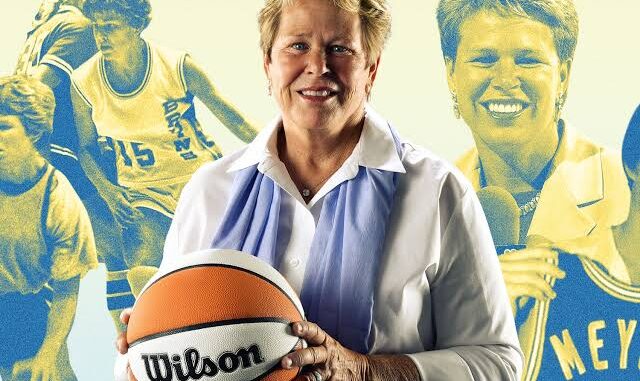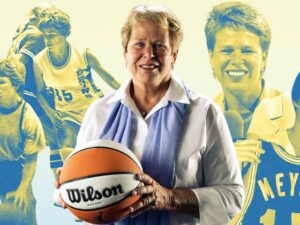
The Athletics Culture Culture The Drysdale Legacy: A Basketball Pioneer Driven by Competition by Ann Meyers The Drysdale Legacy:
A Basketball Pioneer Driven by Competition by Ann Meyers Lukas Weese Ann Meyers Drysdale still remembers her trip to Hinkle Fieldhouse at Butler University. The car consisted of Drysdale and three male basketball players.

This was no ordinary car ride. Drysdale felt fear. This was new territory for the young American. The Indiana Pacers held three days of tryouts to fill roster spots.
Drysdale made history just by being there, as she was the first woman to be selected for an NBA team’s tryouts.
In 1979, she signed a $50,000 no-cut contract (a contract that allows for options within the organization over a period of time) with the Pacers, a first for a woman.
Drysdale believed he belonged on the team. When the Pacers told Drysdale he didn’t make the final roster, he was devastated.
Looking back on the events more than 40 years later, Drysdale does not enjoy the achievement. He doesn’t like attention.
However, Drysdale acknowledges her place in women’s basketball. He was the first player to make the US team while still in high school.
A gold medalist at the 1975 Pan American Games and 1979 FIBA World Championship, he helped Team USA win silver at the 1976 Montreal Olympics.
Drysdale attended UCLA and became the first All-American to hold a four-year athletic scholarship. Off the court, Drysdale is a successful broadcaster calling the WNBA, NBA and Olympics as a color analyst.
Before becoming vice president, she served as the general manager of the WNBA’s Phoenix Mercury, a position she continues to hold today.
Ann Meyers Drysdale spoke at a rally in July in support of the release of Brittney Griner, who had been held in Russia for nearly 10 months.
The success of the mainstays of USA women’s basketball today – Dawn Staley, Sue Bird, Breanna Stewart, Diana Taurasi, A’ja Wilson – was made possible by the pioneers who preceded them.
Chief among these pioneers is Drysdale. “Doors opened for me for some reason,” Drysdale said. “I was in the right place at the right time.” Drysdale grew up in an athletic family.
His father, Bob, was a shooting guard at Marquette before playing professionally for the Milwaukee Shooting Stars, an independent team dating back to the 1940s. Sports were the language that united Bob, his wife Patricia and their 11 children.
Drysdale was the sixth child in a family that often attended his siblings’ sporting events and sat in front of the television watching the Olympics.
She remembers watching field champions Wilma Rudolph and Wyom Tyu and reading a book about all-around athlete Babe Didrikson Zaharias in fourth grade. Drysdale’s dream was to become an Olympian like them.
“It was the early days of television and showing the Olympics,” Drysdale said. “The only women who were really shown as athletes were the Olympians.”
Attending Sonora High School in La Habra, California, Drysdale was an outstanding athlete. In addition to basketball, success followed in softball, badminton, field hockey, tennis and track and field.
He won 13 MVP awards in various sports in high school. “My parents supported their daughters and sons in sports,” Drysdale said.
“With that support system in such a big family, no matter what happens at school or outside the family, I felt it was good to play sports.”
But it was basketball that drew Drysdale the most. He watched his brother Dave develop on the court, both at UCLA and in the States and later with the Milwaukee Bucks.
Drysdale enjoyed the competition and believed that he could be successful in the sport.
Drysdale played AAU women’s basketball at age 14. He also played on the boys varsity summer league team as a junior and senior in high school.
As someone who played against the boys, AAU offered Drysdale the opportunity to compete against the women. This helped her become the first woman to make the US national team as a high school student.
Juliene Simpson played against Drysdale in AAU and remembers Drysdale’s aggressiveness on the court.
Defending, Simpson said Drysdale always had your back. He came up with layups, kicked the ball and took it off the floor.
On offense, Simpson marveled at Drysdale’s use of the backboard with his bank shot. That’s what his brother did at UCLA. “He only knew one speed,” Simpson said.
In addition to determination, there was passion and the desire to be better. You saw the growth and how he became the most dominant player.”
The 1976 Montreal Games were the first Olympics to include women’s basketball. The road to the Olympics for the US women’s basketball team was not easy.
To enter the team, the players had to compete in the Olympics. Four regions – East, West, South and Midwest – held tryouts for the Olympic team.
Drysdale competed in the Western Qualifier in Sacramento, California with over 300 people in attendance. When the coaches cut to 30, Warrensburg, Mo. Drysdale called the latest attempt “competitive.”
The coaches trimmed the roster from 30 to 15 and three alternates, and Drysdale made his first Olympic team. However, the difficulties did not end there.
Initially, the selection tournament was held two weeks before the Olympics in Hamilton, Ontario. The group lived in dormitories at the University of Rochester.
The players trained three times a day and spent the night in an apartment under renovation. After defeating Bulgaria to qualify for the Olympics, the Americans had to endure more unfavorable conditions in Montreal.
Their apartments were cramped and twelve players stayed in one apartment. Drysdale didn’t let those challenges stop him.
The setbacks along the way were just part of the team’s journey to silver, the country’s first Olympic medal in women’s basketball. Every player played an important role.
Coming from a large family, Drysdale helped Jelli along with teammates from different backgrounds. Off the pitch, Drysdale was quiet and did not want to be the center of attention.
Leave a Reply